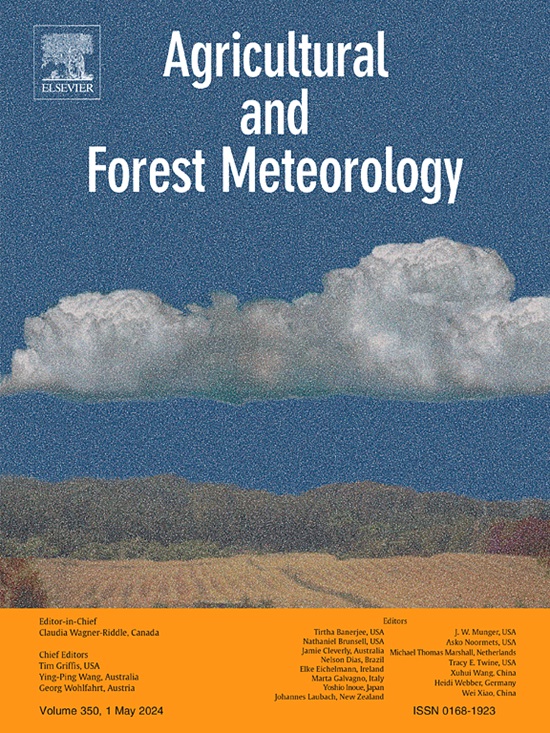甲烷排放对全球湿地恢复的响应及其影响因素
IF 5.6
1区 农林科学
Q1 AGRONOMY
引用次数: 0
摘要
湿地是地球上最大的甲烷(CH4)来源之一。为了恢复退化的生态功能,湿地恢复已在世界范围内实施,但其对CH4排放的影响尚不清楚。本研究通过亚群分析和结构方程模型(SEM)对59个野外研究数据进行综合荟萃分析,评估湿地恢复对CH4排放的响应,并找出关键影响因素。结果表明,湿地恢复后的CH4排放量比受干扰湿地增加122.3%,但仍比自然湿地低21.17%。在所有亚组分析中,恢复湿地的CH4排放量既不显著低于受干扰湿地,也不显著高于天然湿地。恢复湿地的温室气体排放总量不高于受干扰湿地,但显著低于自然湿地(- 22.92%),主要受CH4和CO2排放的影响。在淡水湿地、泥炭地和季节性洪水、高营养物含量或较冷气候的湿地,CH4排放对干扰和恢复特别敏感。盐渍湿地恢复后CH4排放变化不显著。SEM分析发现,恢复水文、盐度、土壤pH、恢复类型和恢复年限是影响CH4排放的主要因素,气候仅起间接作用。这些发现强调了再湿润(至少- 15厘米的地下水位深度)、持续的恢复努力(持续至少5年)和自然植被的恢复(而不是选择性种植物种)对有效湿地恢复的重要性。未采取上述措施的湿地CH4排放量显著低于天然湿地。本研究为深入了解湿地恢复后的CH4排放提供了依据,为全球变化情景下湿地管理策略和CH4排放评估提供了科学依据。本文章由计算机程序翻译,如有差异,请以英文原文为准。
Responses of methane emissions to global wetland restoration and influencing factors
Wetlands are among the largest sources of methane (CH4) on Earth. To restore degraded ecological functions, wetland restoration has been implemented worldwide, but its impact on CH4 emissions remains poorly understood. This study conducted a comprehensive global meta-analysis, integrating data from 59 field studies, to assess CH4 emission responses to wetland restoration and identify key influencing factors through subgroup analyses and structural equation modeling (SEM). Our results indicated that CH4 emissions increased by 122.3 % after wetland restoration compared to disturbed wetlands but remained 21.17 % lower than those of natural wetlands. Across all subgroup analyses, CH4 emissions of restored wetlands were neither significantly lower than those of disturbed wetlands nor significantly higher than those of natural wetlands. The total greenhouse gas emissions of restored wetlands were not higher than those of disturbed wetlands but were significantly lower than those of natural wetlands (−22.92 %), primarily influenced by CH4 and CO2 emissions. CH4 emissions were particularly sensitive to disturbance and restoration in freshwater wetlands, peatlands, and wetlands with seasonal flooding, high nutrient contents, or colder climates. In contrast, saline wetlands exhibited no significant changes in CH4 emissions post-restoration. The SEM analysis identified restored hydrology, salinity, soil pH, restored type, and restored years as the dominant factors influencing CH4 emissions, with climate exerting only indirect effects. These findings underscore the importance of rewetting (to water table depths of at least −15 cm), sustained restoration efforts (lasting at least 5 years), and the recovery of natural vegetation (rather than selective species planting) for effective wetland recovery. CH4 emissions without these measures were significantly lower than those of natural wetlands. This study offers in-depth insights into CH4 emissions following wetland restoration, providing a scientific foundation for wetland management strategies and CH4 emission assessments under global change scenarios.
求助全文
通过发布文献求助,成功后即可免费获取论文全文。
去求助
来源期刊
CiteScore
10.30
自引率
9.70%
发文量
415
审稿时长
69 days
期刊介绍:
Agricultural and Forest Meteorology is an international journal for the publication of original articles and reviews on the inter-relationship between meteorology, agriculture, forestry, and natural ecosystems. Emphasis is on basic and applied scientific research relevant to practical problems in the field of plant and soil sciences, ecology and biogeochemistry as affected by weather as well as climate variability and change. Theoretical models should be tested against experimental data. Articles must appeal to an international audience. Special issues devoted to single topics are also published.
Typical topics include canopy micrometeorology (e.g. canopy radiation transfer, turbulence near the ground, evapotranspiration, energy balance, fluxes of trace gases), micrometeorological instrumentation (e.g., sensors for trace gases, flux measurement instruments, radiation measurement techniques), aerobiology (e.g. the dispersion of pollen, spores, insects and pesticides), biometeorology (e.g. the effect of weather and climate on plant distribution, crop yield, water-use efficiency, and plant phenology), forest-fire/weather interactions, and feedbacks from vegetation to weather and the climate system.

 求助内容:
求助内容: 应助结果提醒方式:
应助结果提醒方式:


